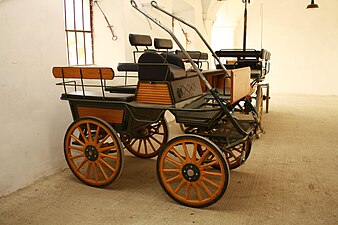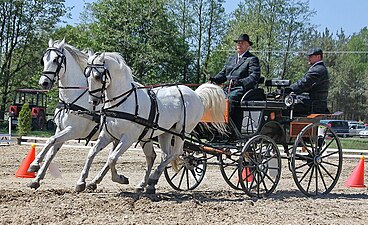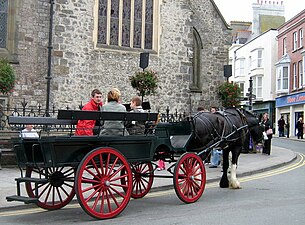
A cart or dray is a vehicle designed for transport, using two wheels and normally pulled by draught animals such as horses, donkeys, mules and oxen, or even smaller animals such as goats or large dogs.

A carriage is a two- or four-wheeled horse-drawn vehicle for passengers. Second-hand private carriages were common public transport, the equivalent of modern cars used as taxis. Carriage suspensions are by leather strapping or, on those made in recent centuries, steel springs. Two-wheeled carriages are usually owner-driven.

A wagon or waggon is a heavy four-wheeled vehicle pulled by draught animals or on occasion by humans, used for transporting goods, commodities, agricultural materials, supplies and sometimes people.

The hansom cab is a kind of horse-drawn carriage designed and patented in 1834 by Joseph Hansom, an architect from York. The vehicle was developed and tested by Hansom in Hinckley, Leicestershire, England. Originally called the Hansom safety cab, it was designed to combine speed with safety, with a low centre of gravity for safe cornering. Hansom's original design was modified by John Chapman and several others to improve its practicability, but retained Hansom's name.

A buggy refers to a lightweight four-wheeled carriage drawn by a single horse, though occasionally by two. Amish buggies are still regularly in use on the roadways of America. The word "buggy" has become a generic term for "carriage" in America.

Shooting-brake is a car body style which originated in the 1890s from horse-drawn carriage origins. The first automotive shooting brakes were manufactured in the early 1900s in the United Kingdom. The vehicle style became popular in England during the 1920s and 1930s, and was produced by vehicle manufacturers or as conversions by coachbuilders. The term was used in Britain interchangeably with "estate car" from the 1930s but has not been in general use for many years and has been more or less superseded by the latter term.

A kalesa, is a two-wheeled horse-drawn carriage used in the Philippines. It is commonly vividly painted and decorated. It was a primary mode of public and private transportation during the Spanish colonial era of the Philippines, though in modern times, they largely only survive as tourist attractions, such as in Vigan, Ilocos Sur.

A brougham was a light, four-wheeled horse-drawn carriage built in the 19th century. It was named after the politician and jurist Lord Brougham, who had this type of carriage built to his specification by London coachbuilder Robinson & Cook in 1838 or 1839. It had an enclosed body with two doors, like the rear section of a coach; it sat two, sometimes with an extra pair of fold-away seats in the front corners, and with a box seat in front for the driver and a footman or passenger. Unlike a coach, the carriage had a glazed front window, so that the occupants could see forward. The forewheels were capable of turning sharply. A variant, called a brougham-landaulet, had a top collapsible from the rear doors backward.

A charabanc or "char-à-banc" is a type of horse-drawn vehicle or early motor coach, usually open-topped, common in Britain during the early part of the 20th century. It has "benched seats arranged in rows, looking forward, commonly used for large parties, whether as public conveyances or for excursions". It was especially popular for sight-seeing or "works outings" to the country or the seaside, organised by businesses once a year. The name derives from the French char à bancs, the vehicle having originated in France in the early 19th century.
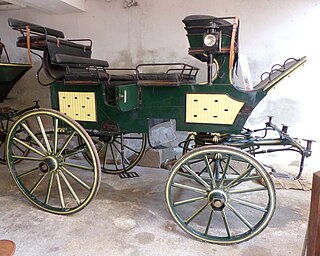
A break or brake is an open horse-drawn carriage commonly used in the 19th and early 20th centuries. It is a heavy four-wheeled vehicle with a high seat for the driver, pulled by two or four horses. Originally, it was used to break young horses to drive or for exercise, so it didn't have much body and was less finished than a formal carriage. Starting in the mid-1800s, the break became popular as a gentleman-driven carriage and many variations appeared. Originally spelled break in England, the spelling brake became common in the latter part of the 1800s and both spellings are used interchangeably.
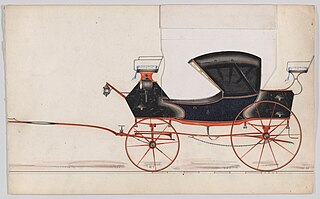
A britzka or britschka is a type of horse-drawn carriage. What was originally an open wagon in Poland and Eastern Europe, became a passenger vehicle in Austria and was exported to Western Europe where it became popular as a travelling carriage. The carriage had four wheels, a long body with two seats, and a folding hood over the rear seat. The body could be converted to sleep two people full length. There was an elevated seat for the driver in front and a rear platform with a rumble seat for servants
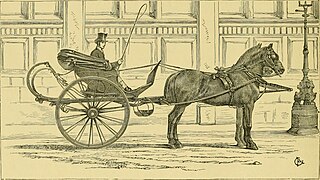
A curricle is a light two-wheeled carriage drawn by two horses abreast. Usually open with a falling hood, it seats two people, plus a liveried groom on a seat or small platform between the rear springs—whose weight might be required to properly balance the carriage. Curricles are harnessed with a pole between the horses, and have an iron crossbar which rests over the harness saddle and supports the weight of the pole. The lightweight "swept" body is hung from a pair of outsized swan-neck cee-springs at the rear, with a minimal dashboard and a pair of lamps in front. For park driving, such as in the Bois de Boulogne or along the seafront at Honfleur, two liveried mounted grooms might follow.

A horse-drawn vehicle is a piece of equipment pulled by one or more horses. These vehicles typically have two or four wheels and were used to carry passengers or a load. They were once common worldwide, but they have mostly been replaced by automobiles and other forms of self-propelled transport but are still in use today.

A dogcart is a two-wheeled horse-drawn vehicle pulled by a single horse in shafts, or driven tandem. With seating for four, it was designed for sporting shooters and their gun dogs, with a louvred box under the driver's seat to contain dogs. It was developed in the early 1800s to afford more seating than the gig, which seats only two. Seating is two back-to-back crosswise seats, an arrangement called dos-à-dos from French. There is a hinged tailboard which lowers slightly and, supported by chains, acts as a footrest for the rear-facing passengers. Some dogcarts had a mechanism to slide the entire body forward or rearward along the shafts to help balance the weight for the horse.

A tonga or tanga is a two-wheeled cart drawn by a single horse. It is used for transportation in the Indian subcontinent. There is a canopy over the body, one seat faces forward for the driver and one passenger, and one seat faces the rear for a second passenger. Some space is available for baggage below the carriage, between the wheels. This space is often used to carry hay for the horses.
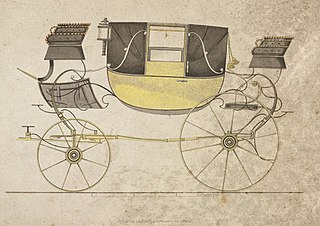
In coachbuilding, a landau is a four-wheeled carriage with a roof that can be let down. It was a luxury carriage. The low shell of the landau provides maximal visibility of the occupants and their clothing, a feature that makes a landau still a popular choice for Lord Mayors in the United Kingdom on ceremonial occasions.

A droshky or drosky is a term used for a four-wheeled open carriage used especially in Russia. The vehicle has a long bench on which the driver or passengers sit as if on a saddle, either astride or sideways. From droga, the pole that connects the front and rear axles.

A vis-à-vis is a carriage in which the passengers sit face to face with the front passengers facing rearward and the rear passengers facing forward. The term comes from the French vis-à-vis, meaning face to face.

A cabriolet is a light horse-drawn vehicle, with two wheels and a single horse. The carriage has a folding hood that can cover its two occupants, one of whom is the driver. It has a large rigid apron, upward-curving shafts, and usually a rear platform between the C springs for a groom. The design was developed in France in the eighteenth century and quickly replaced the heavier hackney carriage as the vehicle for hire of choice in Paris and London.

A horse-bus or horse-drawn omnibus was a large, enclosed, and sprung horse-drawn vehicle used for passenger transport before the introduction of motor vehicles. It was mainly used in the late 19th century in both the United States and Europe, and was one of the most common means of transportation in cities. In a typical arrangement, two wooden benches along the sides of the passenger cabin held several sitting passengers facing each other. The driver sat on a separate, front-facing bench, typically in an elevated position outside the passengers' enclosed cabin. In the main age of horse buses, many of them were double-decker buses. On the upper deck, which was uncovered, the longitudinal benches were arranged back to back.
